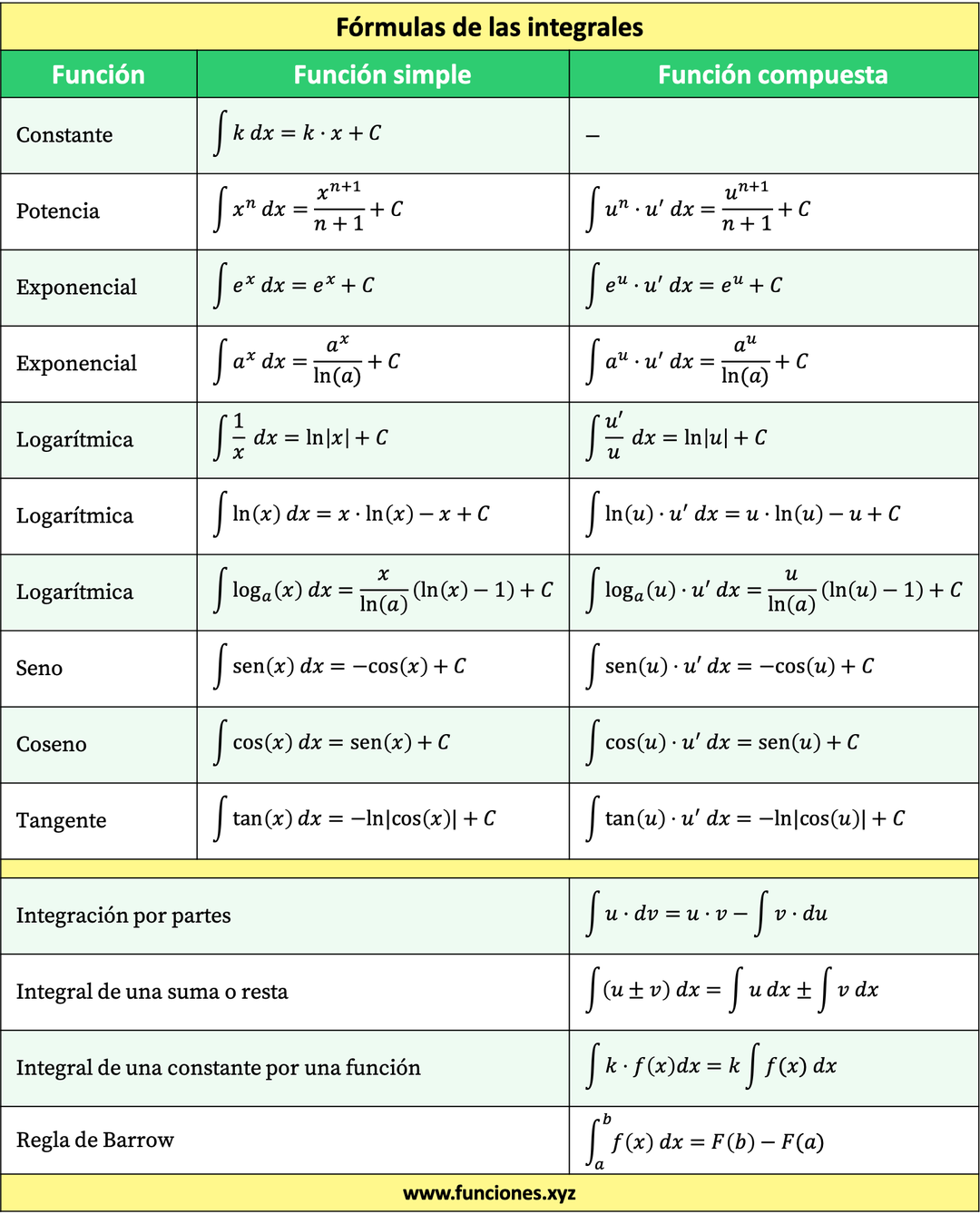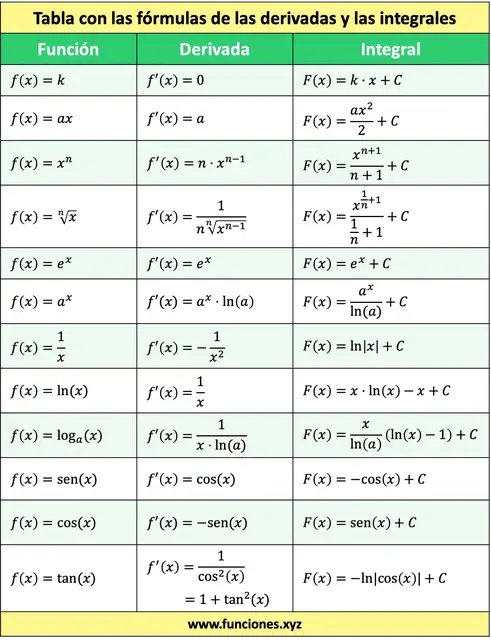Essential Calculus and Probability Formulas
Classified in Other languages
Written on in  English with a size of 7.39 KB
English with a size of 7.39 KB
Probability Concepts
- Union of Events: P(A∪B) = P(A) + P(B) - P(A∩B)
- Complement of an Event: P(Ac) = 1 - P(A)
- Intersection of B and Complement of A: P(B∩Ac) = P(B) - P(A∩B)
- Conditional Probability: P(B|A) = P(A∩B) / P(A)
- Intersection of Complements: P(Ac∩Bc) = 1 - P(A∪B)
- Mutually Exclusive Events: P(A∩B) = 0
- Independent Events: P(A∩B) = P(A)·P(B)
Binomial Distribution Parameters
- Mean (μ): μ = n·p
- Standard Deviation (σ): σ = √(n·p·q)
Binomial Distribution
Notation: B(n, p)
Probability Mass Function: P(X=a) = (na) pa qn-a
Where:
- n = number of trials
- p = probability of success
- q = complement of p (q = 1-p)
Normal Distribution
Notation: X ∼ N(μ, σ)
Important Probabilities:
- P(Z < a) or P(Z > a) can be found using a standard normal table.
- P(Z > a) = 1 - P(Z < a)
- P(Z < -a) = P(Z > a)
- P(Z > -a) = P(Z < a)
Standardization (Z-score): Z = (X - μ) / σ
Example: To calculate P(X > 300) for a normal distribution, adjust for continuity (if approximating a discrete distribution) to P(X > 300.5), then standardize: P(Z > (300.5 - μ) / σ).
Function Domains
- Polynomial, Odd Root Irrational, Exponential, and Trigonometric Functions: Domain is all real numbers (ℜ).
- Logarithmic, Even Root Irrational, and Rational Functions:
- For logarithmic functions, the argument must be strictly positive.
- For even root irrational functions (e.g., square root), the radicand must be non-negative.
- For rational functions, the denominator cannot be zero.
To find the domain, set the expression inside the root/logarithm or the denominator to zero, and use a sign table to determine valid intervals.
Limits of Functions
- Indeterminate Form ∞/∞:
- If the numerator's highest degree is greater, the limit is ±∞.
- If the denominator's highest degree is greater, the limit is 0.
- If the degrees are equal, the limit is the ratio of the leading coefficients.
- Indeterminate Form ∞ - ∞:
- For expressions involving roots, multiply and divide by the conjugate.
- Indeterminate Form 1∞ (or 00, ∞0):
- Use the formula: elim [g(x) · ln(f(x))]
- Indeterminate Forms 0/0 and 0 · ∞:
- Apply L'Hôpital's Rule (if conditions are met).
- Alternatively, rewrite the expression as a fraction to get 0/0 or ∞/∞ form.
Important Values and Properties
- e∞ = ∞
- e1 = e
- e0 = 1
- e-∞ = 0
- k/∞ = 0 (for any finite constant k)
- ∞/k = ∞ (for any finite positive constant k)
- ln(∞) = ∞
- ln(e) = 1
- ln(1) = 0
- ln(0+) = -∞
- ln(negative number) = undefined (does not exist in real numbers)
Continuity of Functions
- Removable Discontinuity: Lateral limits are equal, but not equal to f(a), or f(a) is undefined.
- Jump Discontinuity (Finite): Lateral limits are different and result in finite numbers.
- Jump Discontinuity (Infinite): Lateral limits are different and result in ±∞.
Asymptotes
- Vertical Asymptote (VA): Occurs at x=a if limx→a f(x) = ±∞.
- Horizontal Asymptote (HA): Occurs at y=L if limx→±∞ f(x) = L (where L is a finite number).
- Oblique Asymptote (OA): Occurs at y=mx+n if:
- m = limx→±∞ [f(x)/x] (m must be a finite, non-zero number)
- n = limx→±∞ [f(x) - mx] (n must be a finite number)
Differentiability
A function f(x) is differentiable at a point 'a' if the limit of the difference quotient exists at that point: limh→0 [f(a+h) - f(a)] / h. Differentiability implies continuity at that point.
Monotonicity and Relative Extrema
To determine monotonicity and find relative extrema:
- Calculate the first derivative, f'(x).
- Set f'(x) = 0 and solve for x to find critical points. Also consider points where f'(x) is undefined or where the domain changes.
- Create a sign table for f'(x), including critical points and domain boundaries.
- Increasing: f(x) is increasing where f'(x) > 0.
- Decreasing: f(x) is decreasing where f'(x) < 0.
- Relative Extrema:
- If f'(x) changes from positive to negative, there is a relative maximum.
- If f'(x) changes from negative to positive, there is a relative minimum.
- Substitute the x-values of relative extrema into the original function f(x) to find the corresponding y-values.
Curvature and Inflection Points
To determine curvature and find inflection points:
- Calculate the second derivative, f''(x).
- Set f''(x) = 0 and solve for x to find potential inflection points. Also consider points where f''(x) is undefined.
- Create a sign table for f''(x).
- Concave Up (Convex): f(x) is concave up where f''(x) > 0.
- Concave Down (Concave): f(x) is concave down where f''(x) < 0.
- Inflection Point: Occurs where f''(x) changes sign (from positive to negative or vice versa).
Tangent Line Equation
The equation of the tangent line to a function f(x) at a point (a, f(a)) is:
y - f(a) = f'(a)(x - a)
Key Calculus Theorems
Bolzano's Theorem (Intermediate Value Theorem for Roots)
If f(x) is a continuous function on the closed interval [a, b], and f(a) and f(b) have opposite signs (i.e., f(a)·f(b) < 0), then there exists at least one value c in the open interval (a, b) such that f(c) = 0.
Darboux's Theorem (Intermediate Value Theorem)
If f(x) is a continuous function on the closed interval [a, b], then for any value k between f(a) and f(b), there exists at least one value c in the open interval (a, b) such that f(c) = k.
Lagrange's Mean Value Theorem
If f(x) is a continuous function on the closed interval [a, b] and differentiable on the open interval (a, b), then there exists at least one value c in (a, b) such that:
f'(c) = (f(b) - f(a)) / (b - a)


